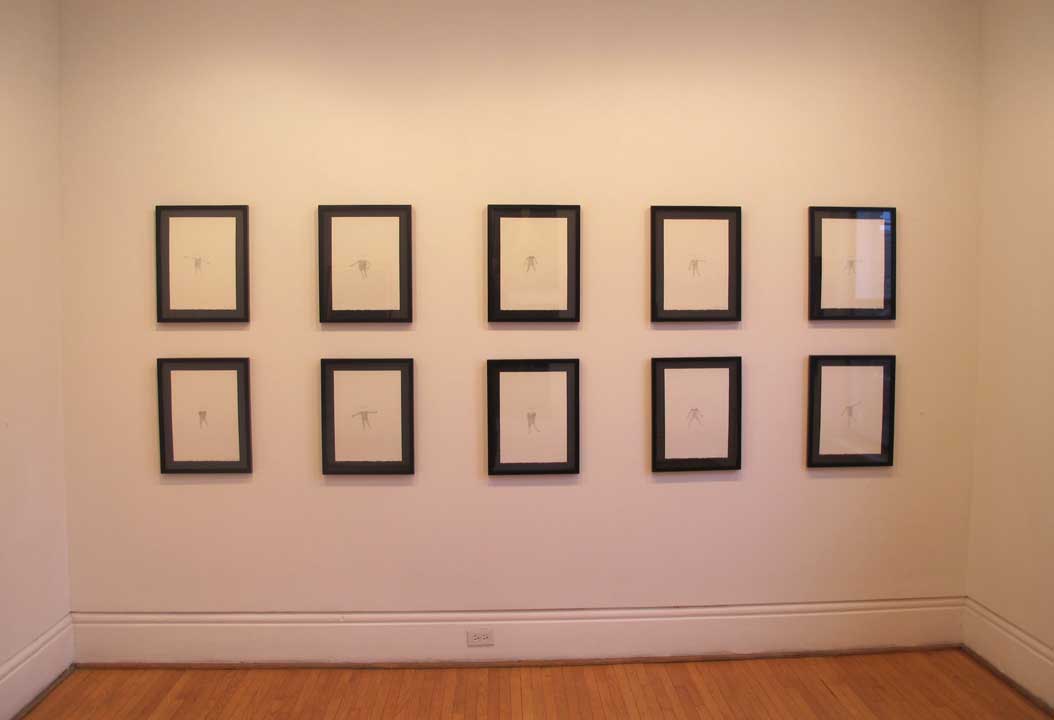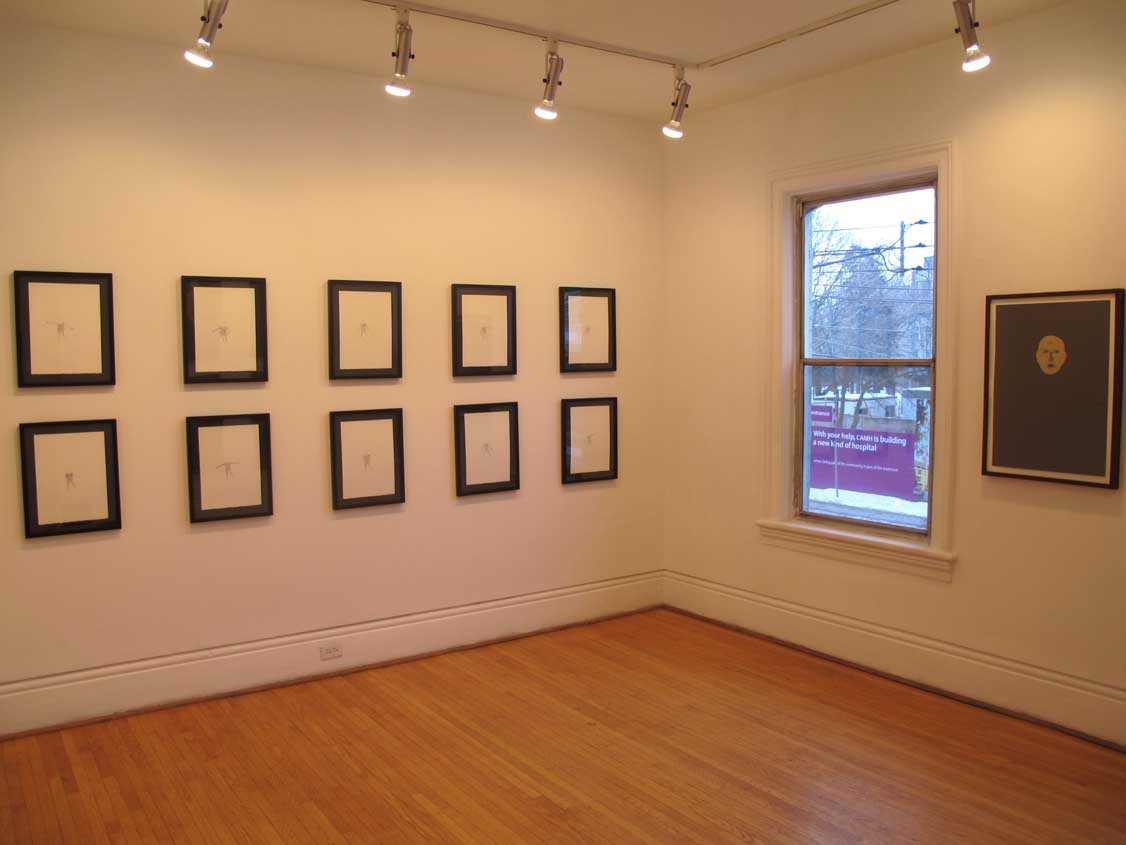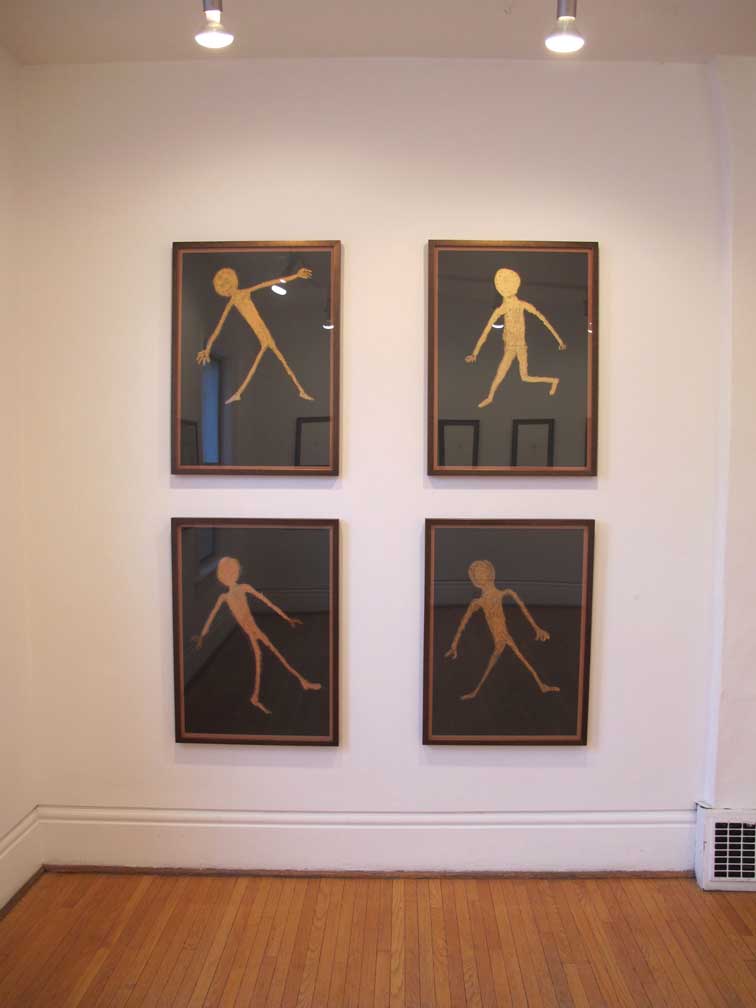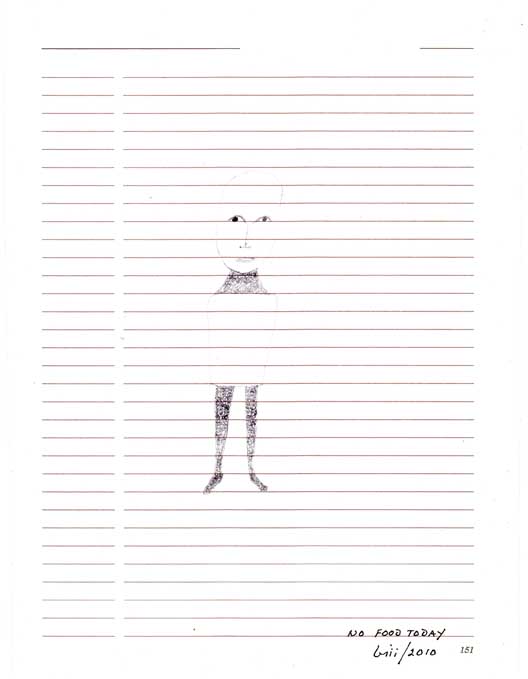Thought Court
Ron Giii
January 21 - February 19, 2011
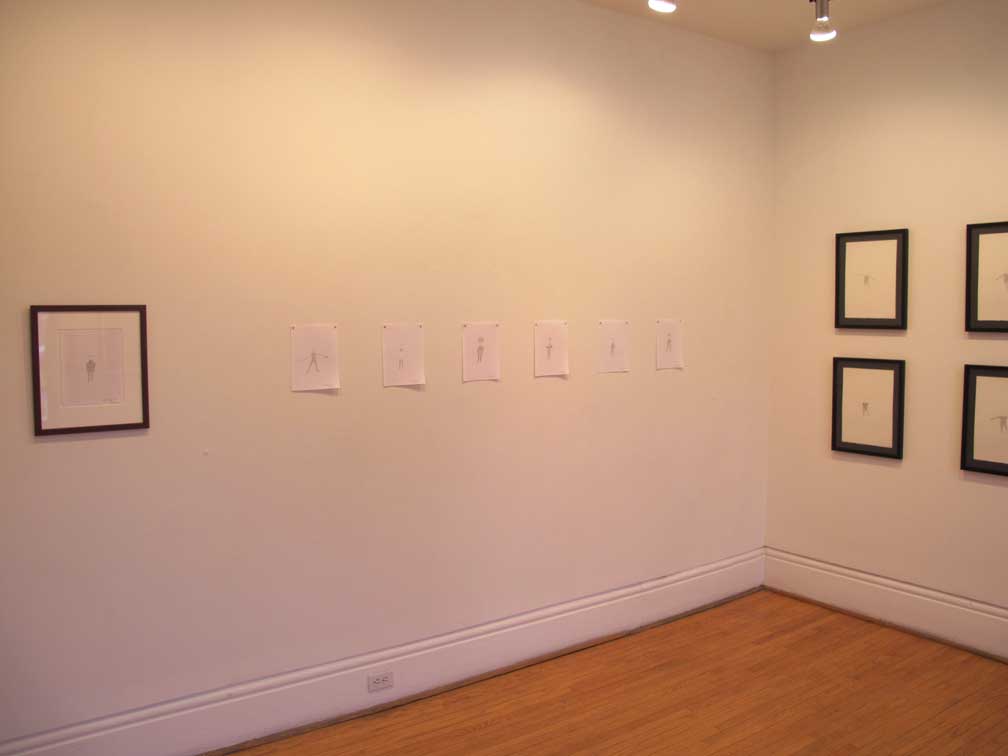
Ron Giii's infamous Shitbandit writings and performances from the 1970s gave way to a drawing practice in the early 1980s. A survey exhibition "Hegel's Salt Man", curated by Rosemary Heather for the Doris McCarthy Gallery in 2007, documents this transition and the ongoing drawing practice that Giii has maintained to this day. A 48-page colour catalogue with essays by Rosemary Heather and Eli Langer is available.
Ron Gillespie was born in 1944 at New Westminster, BC. His earliest training in art took place in 1962-64 at H.S.C. Prince of Wales College, Nairobi, East Africa. He graduated from the Ontario College of Art in 1975. Philosophy, geometry and the anti- modern figure prominently in the work with influences including Artaud, Darwin, Hegel and Spinoza. His work is held in public collections across Canada, including the National Gallery of Canada and the Art Gallery of Ontario.
For his current exhibition Giii has provided three related bodies of work on three different scales. The larger drawings are in pastel on a dark brown paper, smaller scale drawings in graphite on white paper and a third, even smaller scale, on lined white paper.
An avid reader, Giii has turned up a text by Rosalind Krauss from 1974 that he applies to the smallest drawings:
"Two types of shape (the visible and the implied) and two types of line (the abstract and the natural)." 1
1. Rosalind Krauss "Richard Serra: Sculpture Redrawn" Artforum May 1972, page 151 (later published in Krauss' "Perpetual Inventory" - a collection of Krauss' writing from the mid-1970s).
With Serra's sculpture the works appear deeply anchored in the land and the mind's eye pictures the substructure, imbedded deep in the ground, as a way to visually embrace the entirety of the work, seen and unseen, according to Giii. The large open spaces around Giii's centrally located drawings are equated with freedom. He views his drawings on lined paper accordingly, expressed in his unique writing form:
"With reading a line in real time there is also the undiscovered line which may come in a drawing not yet submitted. With the little drawings lines cut across the face or body and may be seen as the background or foreground of the piece. Rosalind Krauss sees the abstract line as an art world sculpture which has a brilliant take on studies on supremacy. Now as the shift works Modernism has returned via the paper with no lines left which means the definition society has one last chance to see itself."
A second text, on the subject of intentionality, followed:
"Contemporary philosophers sometimes describe the intensionality (sic) of mental states as their aboutness.It is this act of drawing things rather than an apple or orange so much so that representation can avoid itself until the moon shines at night.In other words the end of drawing is quite often the last ship too arrive in Naples where artist can wander away from Divinity and see the last moments of the Renaissance. Soon your name will follow the rivers of the streets and a small room to have a glass of wine for your family...ron giii Jan 13th 2011".
Here is a link to our web site and an important piece of Giii's writing on drawing first published by the 49th Parallel, Canada's gallery in New York City, on the occasion of an exhibition of Giii's drawings in 1986. http://www.paulpetro.com/arc/giii/2005-a.php
The following is an abridged text based on Rosemary Heather's essay for Ron Giii's survey exhibition "Hegel's Salt Man" (2007) organized by the Doris McCarthy Gallery at the University of Toronto and touring to the Carleton University Art Gallery (2008) in Ottawa, ON.
Ron Giii: Hegel’s Salt Man
Rosemary Heather
“During the clearance and fixation of the 4th salt man, experts found an iron dagger in the scabbard attached to his waist. Also, two ceramic jugs have been found with a kind of oil inside which, scholars believe, could have been used for a lantern.” - Abolfazl Ali, head of Chehr-abad research group
“To open the doors of the Atomic Theatre your eyes have to open up like a vast reservoir of water falling from another planet. Once the mind has turned inside out, the springs of time will emerge as the centre of your cognition. The Atomic Theatre takes its pulse from the anti-matter of materials that exist in an unknown dimension called invisibility.” - Ron Giii, The Atomic Theatre and The Dictator's Opera (1984-86) - 49th Parallel, NYC, 1986.
Ron Gillespie
Things change. Not in itself a novel statement, but one worth reflecting on. This is especially true if you have the materials at hand to give substance to the idea. Work made by an artist over the course of 35 years provides the perfect vessel for these considerations; in an artist’s body of work you can see what changes and what stays the same, much like a body itself. This is also to say, art provides the best answer to the question: Why are we here?
If you ask Ron Giii, the continuities that both defy and define the present are “the anti-matter of materials that exist in an unknown dimension called invisibility.” Even in this fragment from the artist’s writings there is so much to discuss; as in his work as whole: depth-mine and you will discover riches.
Ron Giii
Giii’s work forms itself at the point where the invisible meets the visible; another word for this is the theatre, which is like visual art in that each takes place within a framework or proscenium arch. Theatre is the forum where anti-matter becomes visible; precisely because the primary consideration of art is form. In Giii’s case, artistic form and the forum of its presentation converge in a way that is especially distinctive. To quote the sentence in full: “The Atomic Theatre takes its pulse from the anti-matter of materials that exist in an unknown dimension called invisibility.”
The above quote is from a text written by Giii to accompany a show of his drawings in New York City in 1986. A wholly coherent statement about the artist’s oeuvre, the text and the show also provide a good pivot point to consider the stages of Giii’s career. What began as performance continues as drawing, all of it taking place within the conceptual framework of theatre. In Giii’s view, the theatre is an idea that formalizes the process of becoming that is all of our lives. Like us, the figure within the frame or on the stage, looks outwards, seeks a connection with others and beckons to an audience, more often than they turn their back to the world. The proscenium, like the page, is a threshold of possibility waiting for the moment of its random apprehension.
Uncle Ron
Looking at Giii’s work one understands the simple encounter as his fondest hope for it; which means that his works are this encounter, such is the imperceptible ease with which they fulfill this desire. The drawings live and shimmer with unimagined sensitivity. In The Atomic Theatre, he speaks about the figures in his drawings as real people, “laughing and hiding from me as if they had their own reality.”
Giii began as an artist, already active and engaged in the Toronto scene, when he was a student at what was then the Ontario College of Art (now OCAD) in the 1970s. It was a cultural moment when the bohemian sectors of society were alive with dreams and ambitions that are difficult to fully access today. Giii’s early works provide a way in. At the time, ‘live art’ was a fringe pursuit. In 1978, Roselee Goldberg, writing in the first authoritative study about performance noted that it had only recently been accepted as “a medium of artistic expression in its own right.” Like other practices in the visual arts in that moment, it was a hybrid – theatre or sculpture and dance – newly unbound from traditional constraints. In common with much that happened post minimalism, performance art found its possibility – got permission – in the space of the gallery itself.
Jimmy Algebra
Pervading the era when Giii first started working were the powerful cultural tendencies of political radicalism and lifestyle utopianism, not to mention the commercialism of these trends in their pop cultural mirror, and its inevitable distortion. Artistic disciplines were intermingling, to electric effect. Along with freedom from medium specificity and necessary craft, was an embrace of ordinary things as subject matter for art, including garbage and noise – the incidental art of John Cage and Fluxus – and above all, people. The ‘Happenings’ of the 1960s were the audience re-imagined as painting and sculpture, with the gallery as frame. In this context, real human bodies – especially the naked ones – were the ultimate representation of the outside world. It was an invasion of everything that had previously been exterior to art.
Shock value, derived from the simple fact of the body – naked or otherwise – and the things you could do with it, was a basic element in Giii’s art at that time. While both were still students, Kimo Eklund and Giii created the performance entity, SHITBANDIT. By Giii’s account:
We used the name to shatter the very conservative milieu surrounding OCA…we did Christ on a pair of 2 by 4s with microphones placed out in the street, and a used Volkswagen where males and girls got it on and they were surrounded by porn mags.
Johnny Pizza
A site for many of Giii’s early performances was the Centre for Experimental Art and Communication (CEAC) in Toronto, one of Canada’s first artist run centers that had a short, explosive history. Ever more radical in the theoretical and political platforms it promoted, CEAC eventually lost its government funding, its many provocations bearing the fruit of a notoriety that is increasingly obscure – and which appears to have little relevance to the activities and self-image of the Toronto arts scene today.
As part of a group of artists associated with CEAC, Giii traveled and performed extensively in Europe and the US. A 1976 tour, for instance, took the group to Sweden, Germany, Italy and Belgium. Communicating via among other things the postal system rather than the internet, they were part of the first globalized network for artists’ that was made possible by the dematerialization of the artwork. Tuer comments on the intense schedule of activities carried out by CEAC. She notes: “During 1976 and 1977, there was literally an event held at CEAC every night of the week.” As with everything, the moment was fleeting; as Giii says: The performances were wild like animals who were going extinct…
The General
In her fascinating and very thorough scholarly essay on the history of CEAC , Dot Tuer notes the influence of Hermann Nitsch and the Viennese Actionists on the kind of performance work Giii, SHITBANDIT, and others did at CEAC. Self-exposure, transgression and ritualized actions form a common thread, the goal being to orchestrate a moment of ‘raw’ experience for audience and performer. Informing it all was the idea that confrontational art stripped away layers of falsity, in consciousness and social interactions, the naked individual in the gallery of itself offering the promise of a return to Rousseauian innocence and/or political consciousness, or some combination of the two.
Whereas the Vienna Actionists were motivated by the desire to expose the incipient societal guilt stemming from not so distant (Nazi) past, Canadian shock performance tactics had the broader target of the individual’s implication in a generally corrupt society. Giii: after reading texts on the destruction of nature we adapted the wild behaviour and hence we entered the world of dominance, force, power and abuse. This critique continues on in ‘Taste’, the only surviving example of Giii’s work in Super 8. Shot in a garbage strewn alley for about $100 in 1984, in ‘Taste’ Giii and Darinka, his female accomplice, subject each other and themselves to a series of ad hoc actions. By turns disturbing and theatrical, the performers’ actions also have quasi-sado-masochistic overtones. But in the film, Giii’s intention is not to shock. He makes this clear in the soundtrack he narrates for ‘Taste’, which he did spontaneously in a single take, after the fact, in compliment to the film’s continuous improvisational performance. “The artist is a fascist” Giii intones many times throughout the film, questioning the power dynamics inherent to the artist’s relationship to the audience and to the work of art. By enacting a theatrical sado-masochism in the film, Giii indicts himself, but like the doctrine of original sin itself, this is only to declare that he is part of humanity.
Hegel’s Salt Man
In his later work, Giii’s investigations into the dynamics of power give way to tenderness and vulnerability. The figures in his drawings always appear to be fragile, and are rendered with the lightest of touches, like a mere breath upon the page. Frequently, the figures float inside a box, or intersecting lines that delineate geometric space. Together the lines and the figure represent a self that grapples with and must survive life’s intractable circumstance, and that does so with moments of joy and lucidity. Another quote from Giii: “Each instance of conception is a view of a theatre that has no words nor semblance of a rational world with all its contradictions and confusion.” There is a biographical ‘before’ and ‘after’ in this timeline, roughly sketched out in the text above, that corresponds to Giii’s experience with bipolar disorder, the drawings belonging with the ‘after’ that continues to this day. More striking, however, is the work’s extraordinary coherence and wholeness, as if all of it were of a piece, antimatter that was once and will be again invisible, that is available as a point of contact in this moment, and yet just passing through.







